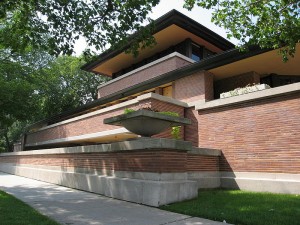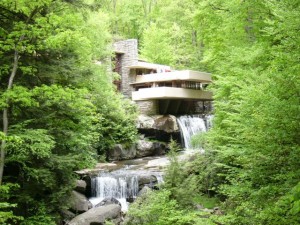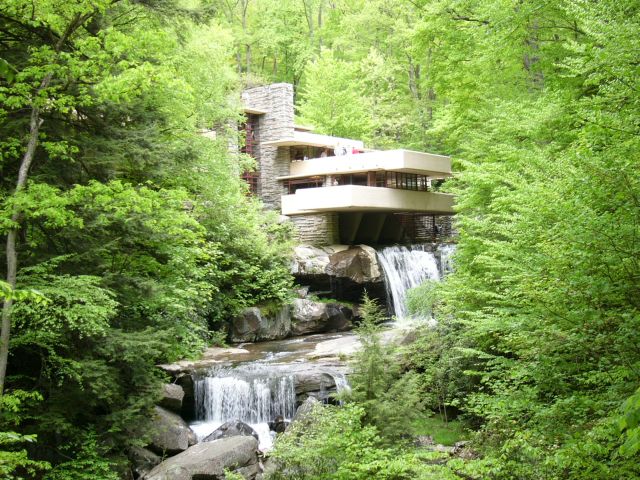Frank Lloyd Wright was an American architect born on June 8, 1867 in Richland, Wisconsin. At the age of ten, Wright later moved to Madison, Wisconsin in 1877 with his family. After settling in Madison, Wright spent many of his summers on his uncle’s farm on the Wisconsin countryside in a town called Spring Green. 1 Scholars will later say that Wright’s time on the open fields and wide planes at his uncle’s home was a tremendous influence on Wright’s prairie-house style. 2 Many consider Wright to be one of the first American architects to create a uniquely American design aesthetic. Similar to the far reaching planes Wright witnessed on his uncle’s farm, Wright’s prairie style has a similar emphasis on horizontality. In addition to the influence of the prairie, Wright’s introduction to Froebel Blocks, given to him by his mother, are similarly cited as early influencers of Wright’s geometric and plane-oriented architecture. 3
Later in his adult life Wright moved to Chicago; drawn to the influx of architectural demand due to the Great Fire of 1871 that destroyed much of Chicago’s infrastructure. There, Wright was employed by Alder & Sullivan and was quickly promoted to head draftsman. 4 However, due to a breach of contract only a short time into Wright’s five year contract with Alder & Sullivan, Wright left to start his own practice. Only after he opened up his own practice does Wright truly develop his own architectural style in his pursuit of designing private residences. 5
Wright is frequently noted for his signature prairie style homes. The Frederick C. Robie House, located in Chicago, Illinois, is often referred to as one of the most indicative and representative designs of Wright’s prairie style. 6 Designed for the successful businessman, Frederick Robie, features of the house include a strong emphasis on horizontality with several overlapping rectangular planes. These are seen to culminate into dramatic cantilevers that jut out over varying spaces. As seen in Figure 1, Wright’s work clearly demonstrates an emphasis on horizontal planes and an adherence to geometric forms.

In addition to the prairie style homes, Wright also designed several other homes for other wealthy patrons. Another representative design of Wright’s was that of Fallingwater. Fallingwater was a summer home built for a wealth Pittsburgh couple in Bear Run, Pennsylvania. 7 Wright uses many local materials yet incorporates many contemporary techniques. Wright’s use of locally sourced stones for the exterior and interior masonry allows the structure to blend in with its surrounding. 8 In addition, the use of glass further blends the boundaries of interior and exterior spaces, as seen in Figure 2. Fallingwater is in and of itself cantilevered out over the waterfall and blends seamlessly with its surroundings.

Though he was most famous for being an architect, Frank Lloyd Wright also lectured frequently, authored many articles discussing architectural techniques, and received many awards and accolades for his work. Most notably, Wright received a Gold Medal from the American Institute of Architects, the Medici Medal in Florence, Italy, the Royal Gold Medal for Architecture from King George VI of England, and honorary degrees from institutions such as Princeton University. 9 In his lifetime, Frank Lloyd Wright designed 1,114 architectural works, 532 of which were brought to fruition. At the age of 91, Frank Lloyd Wright passed away in Phoenix, Arizona and was buried in his family’s Unity Chapel Cemetery in Spring Green, Wisconsin. 10
– J.X.
Figure 1: Frederick C. Robie House (1908-1910), Chicago, IL. Frank Lloyd Wright. Photographer: David Arpi, Wikimedia Commons. Link.
Figure 2: Fallingwater (1936-1938), Bear Run, PA. Frank Lloyd Wright. Photographer: Serinde, Wikimedia Commons. Link.
Notes:
- “Visual Timeline.” The Frank Lloyd Wright Foundation. Accessed October 31, 2015. ↩
- “Frank Lloyd Wright; Biography.” The Frank Lloyd Wright Foundation. Accessed October 30, 2015. ↩
- “Visual Timeline.” Accessed October 31, 2015. ↩
- Ibid. ↩
- Arthur Lubow. “The Triumph of Frank Lloyd Wright.” Smithsonian. Accessed October 31, 2015. ↩
- “About the Robie House.” Scholastic. Accessed November 1, 2015. ↩
- “Visual Timeline.” Accessed October 31, 2015. ↩
- Ibid. ↩
- Ibid. ↩
- Ibid. ↩
